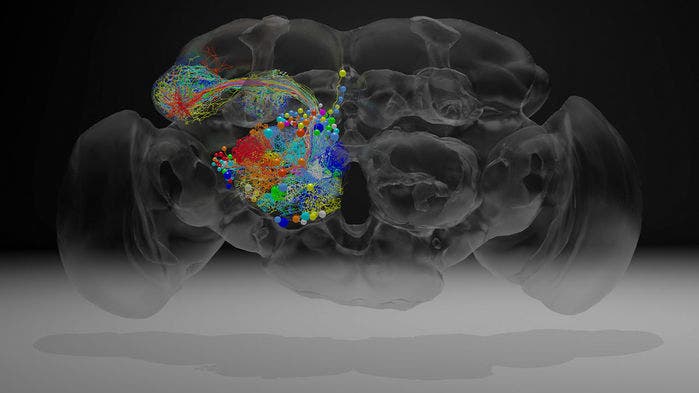No fewer than 21 million images and 7,062 brain slices, all obtained using two high-speed electron microscopes — those are the results of the most detailed digital snapshot of the adult fruit fly brain.

For most of us, fruit flies (Drosophila melanogaster) are little more than a nuisance, buzzing around our over-ripe fruits. But for brain scientists, fruit flies provide an excellent model. Recently, a team of scientists at the Howard Hughes Medical Institute’s Janelia Research Campus in Ashburn, Virginia, managed to map a fruit fly brain in unprecedented detail, identifying the individual synapses (junctions between neurons).
Essentially, they’ve created a visible neuronal roadmap, underpinning the web of connections that underpin specific fly behaviors.
“The entire fly brain has never been imaged before at this resolution that lets you see connections between neurons,” explains Davi Bock, a group leader at Janelia who reported the work along with his colleagues on July 19, 2018, in the journal Cell.
“We think it will tell us something about how the animal learns – how it associates odors with a reward or punishment,” he explains.
The fruit fly has 100,000 neurons (for reference, humans have 100 billion). Each of those neurons branches out to reach other neurons, forming incredibly dense communication circuits.
Scientists can view these circuits, using a technique called serial section transmission electron microscopy. The technique, which has been developed for brain imaging but can also be applied to other fields, generates high-resolution three-dimensional images from small samples.
[panel style=”panel-default” title=”Serial section transmission electron microscopy” footer=””]
Firstly, researchers dip the fly’s brain into a cocktail of heavy metals which mark the outline of each neuron, as well as its connections. Then, a small block of resin is prepared and ultrathin serial sections (100 nm thick) are cut using a specialized diamond “knife“. Some 7,000 slices are obtained.
The cuts are mounted on the block, where after further preparation, researchers hit the brain slices with a beam of electrons, which passes through everything except the metal-coated areas.
“It’s the same way that x-rays go through your body except where they hit bone,” Bock adds.
They used two electron microscopes which have a much higher resolution than conventional light microscopes.
[/panel]
Traditionally, this process has been extremely slow. Everything had to be done by hand, and each photo had to be snapped individually. Imagine if you wanted to take 21 million photos — you’d be snapping for decades, Bock says. So he and his colleagues developed new tools to aid in this task, including two custom-built systems to rapidly move tissue samples in eight-micrometer increments, allowing them to quickly capture images of neighboring areas. With this, it only took seven minutes to image a brain slice — which is five times faster than the previous record. Engineers at Janelia also built a robotic loader that picks up and places samples automatically to help Bock’s team.
It’s remarkable how complex the fruit fly’s brain is, with so relatively few neurons.
“They can learn and remember. They know which places are safe and dangerous. They have elaborate sequences of courtship and grooming,” Bock explains.
For instance, Bock’s team followed a neuronal path that reaches out to the so-called mushroom body — a pair of structures in the brain of insects known to play a role in olfactory learning and memory. These cells have been described previously, but the new study allowed researchers to trace their outline more easily and confirm previous findings.
Moving on, there are many other neuronal pathways of interest which researchers will no doubt soon look into. Using the technical capabilities described in this new paper, it seems like researchers will able to move on to more human-like creatures, and that’s where things really start to get interesting.
The fruit fly brain dataset has been released and can be accessed and downloaded at temca2data.org. More than 20 lab groups are already working on the newly released dataset.
Journal Reference: Zheng et al. “A complete electron microscopy volume of the brain of adult Drosophila melanogaster,” Cell. Published online July 19, 2018.
Was this helpful?



